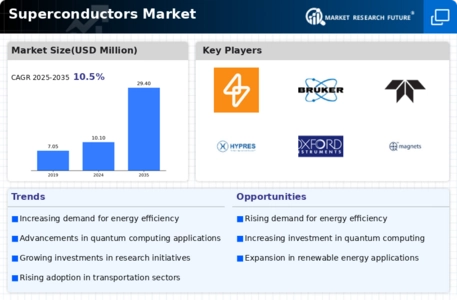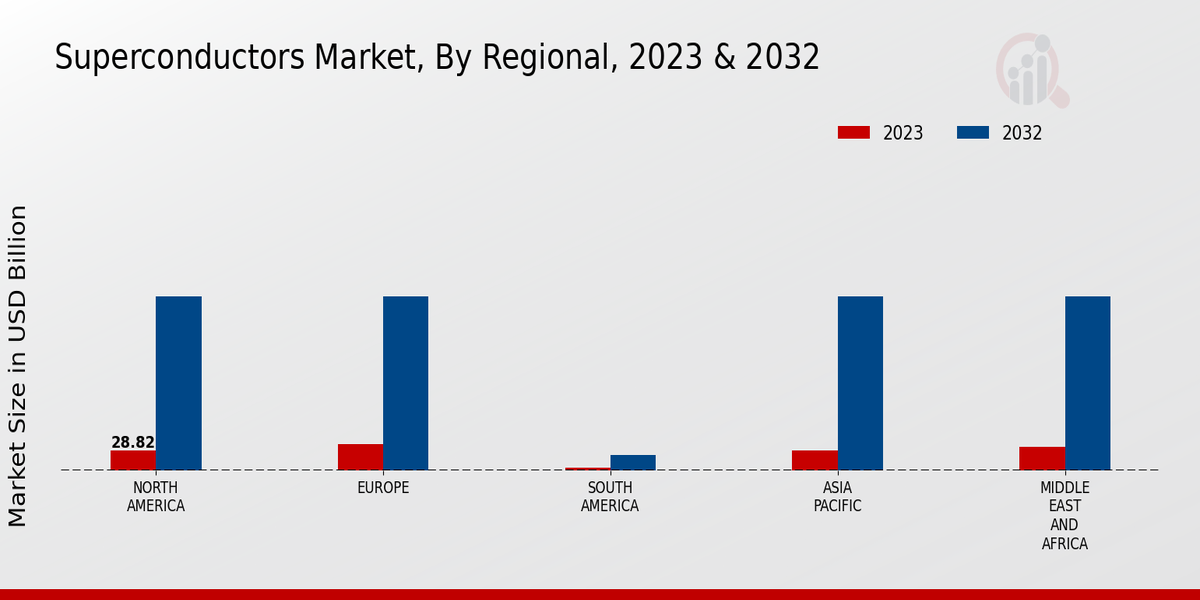Market Growth Projections
The Global Superconductors Market Industry is poised for substantial growth, with projections indicating a rise from 10.1 USD Billion in 2024 to 29.4 USD Billion by 2035. This growth trajectory suggests a compound annual growth rate (CAGR) of 10.23% from 2025 to 2035. Factors contributing to this expansion include increasing demand for energy-efficient solutions, advancements in medical technologies, and government support for research and development. The market's evolution reflects a broader trend towards sustainable and innovative technologies, positioning superconductors as a critical component in future industrial applications.
Government Initiatives and Funding
Government initiatives and funding play a crucial role in propelling the Global Superconductors Market Industry forward. Various countries are investing in research and development programs aimed at enhancing superconducting technologies. These initiatives often focus on applications in energy, transportation, and healthcare, fostering innovation and commercialization. For instance, funding for superconducting research in the United States and Europe has led to breakthroughs in material science and engineering. Such support is likely to stimulate market growth, as public and private sectors collaborate to harness the potential of superconductors in addressing global challenges.
Rising Demand for Energy Efficiency
The Global Superconductors Market Industry experiences a notable surge in demand driven by the increasing need for energy-efficient technologies. Superconductors, known for their ability to conduct electricity without resistance, present a viable solution to energy loss in electrical systems. As industries and governments focus on reducing carbon footprints, the adoption of superconducting materials in power grids and transportation systems is likely to rise. In 2024, the market is projected to reach 10.1 USD Billion, reflecting a growing recognition of superconductors as a key component in achieving energy efficiency goals.
Emerging Technologies and Innovations
Emerging technologies and innovations are pivotal in shaping the Global Superconductors Market Industry. The development of new superconducting materials, such as iron-based superconductors and high-temperature superconductors, is expanding the potential applications of superconductors across various sectors. Innovations in cryogenic cooling systems and fabrication techniques further enhance the performance and feasibility of superconducting technologies. As these advancements continue to unfold, they are expected to attract investment and interest from diverse industries, thereby propelling market growth. The dynamic nature of technological progress suggests a promising future for superconductors in various applications.
Growing Applications in Transportation
The Global Superconductors Market Industry is witnessing a growing interest in the application of superconductors within the transportation sector. High-speed trains utilizing superconducting magnetic levitation technology are gaining traction, offering faster and more efficient travel options. Countries like Japan and China are leading in the implementation of these technologies, which could revolutionize public transportation. The increasing focus on sustainable transport solutions is likely to drive demand for superconductors, contributing to the market's growth trajectory. As the industry evolves, the integration of superconducting technologies in transportation systems may become more prevalent.
Advancements in Medical Imaging Technologies
The Global Superconductors Market Industry is significantly influenced by advancements in medical imaging technologies, particularly in magnetic resonance imaging (MRI). Superconducting materials are essential for the development of high-field MRI systems, which offer improved image resolution and diagnostic capabilities. As healthcare providers increasingly invest in advanced imaging technologies, the demand for superconductors is expected to grow. The market's expansion aligns with the projected growth from 10.1 USD Billion in 2024 to an estimated 29.4 USD Billion by 2035, indicating a robust CAGR of 10.23% from 2025 to 2035.









